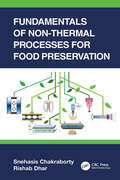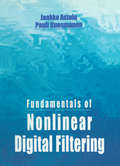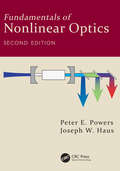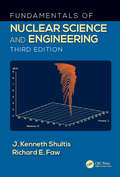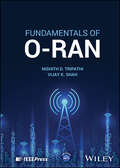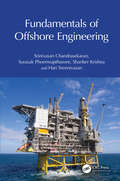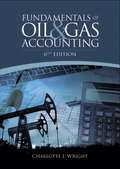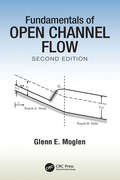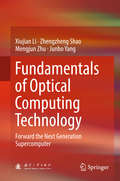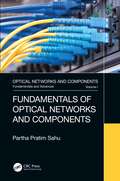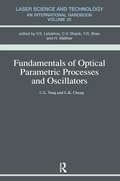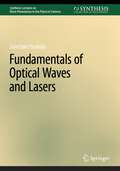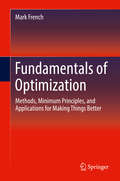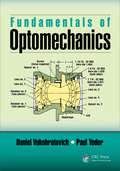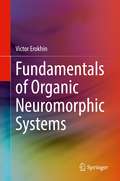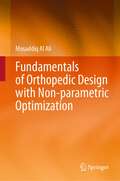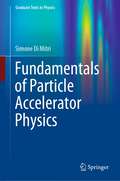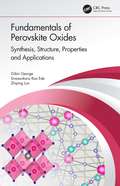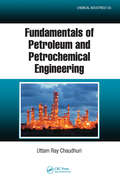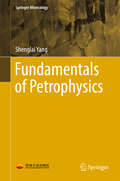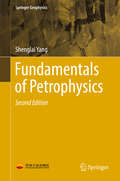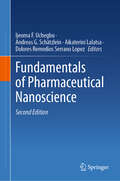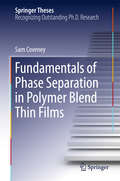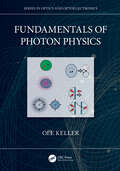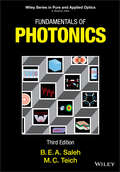- Table View
- List View
Fundamentals of Non-Thermal Processes for Food Preservation
by Snehasis Chakraborty Rishab DharThe ten chapters of this textbook, written in a simple but scientific language, encompass all the non-thermal treatments in-depth, from basic concepts to technological advances. The book provides complete study material in a single source including such pedagogical features as multiple-choice questions, solved numerical problems, and short questions. The book begins with a general introduction to the evolution of the non-thermal technique for food preservation. The fundamental mechanism of thermal inactivation of microorganisms and enzymes is discussed. In the following chapters, a set of seven non-thermal techniques have been discussed in detail.
Fundamentals of Nonlinear Digital Filtering (Electronic Engineering Systems Ser. #8)
by Jaakko Astola Pauli KuosmanenFundamentals of Nonlinear Digital Filtering is the first book of its kind, presenting and evaluating current methods and applications in nonlinear digital filtering. Written for professors, researchers, and application engineers, as well as for serious students of signal processing, this is the only book available that functions as both a reference handbook and a textbook. Solid introductory material, balanced coverage of theoretical and practical aspects, and dozens of examples provide you with a self-contained, comprehensive information source on nonlinear filtering and its applications.
Fundamentals of Nonlinear Optics, Second Edition
by Joseph W. Haus Peter E. PowersPraise for the 1st Edition: "well written and up to date…. The problem sets at the end of each chapter reinforce and enhance the material presented, and may give students confidence in handling real-world problems." ?Optics & Photonics News "rigorous but simple description of a difficult field keeps the reader’s attention throughout…. serves perfectly for an introductory-level course." ?Physics Today This fully revised introduction enables the reader to understand and use the basic principles related to many phenomena in nonlinear optics and provides the mathematical tools necessary to solve application-relevant problems. The book is a pedagogical guide aimed at a diverse audience including engineers, physicists, and chemists who want a tiered approach to understanding nonlinear optics. The material is augmented by numerous problems, with many requiring the reader to perform real-world calculations for a range of fields, from optical communications to remote sensing and quantum information. Analytical solutions of equations are covered in detail and numerical approaches to solving problems are explained and demonstrated. The second edition expands the earlier treatment and includes: A new chapter on quantum nonlinear optics. Thorough treatment of parametric optical processes covering birefringence, tolerances and beam optimization to design and build high conversion efficiency devices. Treatment of numerical methods to solving sets of complex nonlinear equations. Many problems in each chapter to challenge reader comprehension. Extended treatment of four-wave mixing and solitons. Coverage of ultrafast pulse propagation including walk-off effects.
Fundamentals of Nuclear Science and Engineering
by J. Kenneth Shultis Richard E. FawFundamentals of Nuclear Science and Engineering, Third Edition, presents the nuclear science concepts needed to understand and quantify the whole range of nuclear phenomena. Noted for its accessible level and approach, the Third Edition of this long-time bestselling textbook provides overviews of nuclear physics, nuclear power, medicine, propulsion, and radiation detection. Its flexible organization allows for use with Nuclear Engineering majors and those in other disciplines. The Third Edition features updated coverage of the newest nuclear reactor designs, fusion reactors, radiation health risks, and expanded discussion of basic reactor physics with added examples. A complete Solutions Manual and figure slides for classroom projection are available for instructors adopting the text.
Fundamentals of O-RAN
by Nishith D. Tripathi Vijay K. ShahComprehensive reference on O-RAN technology, covering its history, architecture, security, ecosystem, and more, with didactic resources included throughout Discussing both basic and advanced concepts, Fundamentals of O-RAN delivers a comprehensive summary of O-RAN, covering its history, architecture, control loops and microservices (i.e., xApps and rApps), security, ecosystem, R&D initiatives, and challenges and evolution toward 6G. The book not only includes key theoretical principles of O-RAN, but also provides a framework for the reader to carry out guided hands-on exercises through online auxiliary materials. Homework problems and review questions are included in online auxiliary materials to reinforce learning. The book includes instructions on how to create xApps, which are expected to be one of the most promising aspects of O-RAN; for example, by working with an end-to-end O-RAN system using a network slicing functionality where the rApp provides slicing specified policies to the xApp which then allocates the base station’s spectrum resources based on the slicing policy to each user (belonging to a certain slice). Readers will also gain an understanding of cellular networks, particularly radio access networks, software virtualization, and software-defined networking concepts, and the knowledge needed to design, build, and test a 5G O-RAN system. Some of the sample topics explored in Fundamentals of O-RAN include: RAN evolution from black box 4G RAN to software-based and virtualized RAN (vRAN) Components of the O-RAN architecture including SMO, Non-RT RIC, Near-RT RIC, O-CU-CP, O-CU-UP, O-DU, O-RU, and O-Cloud xApp design and prototyping from scratch using open cellular software, srsRAN and O-RAN Software Community (OSC) software. Examination of various security dimensions inherent in the O-RAN architecture. Testing and integration, covering Open Test and Integration Centers (OTICs), global PlugFests, certification and badging, and end-to-end test specifications Work Groups (WGs), including WG1 to WG11, and focus groups, with information on how to obtain WG specifications Fundamentals of O-RAN is an essential reference for the workforce of tomorrow’s cellular industry, including graduate students, teachers, researchers, faculty members, engineers, and employees involved in the field of wireless networks, especially radio networks.
Fundamentals of Offshore Engineering
by Srinivasan Chandrasekaran Surasak Phoemsapthawee Shanker Krishna Hari SreenivasanFundamentals of Offshore Engineering addresses the basics of design for offshore oil and gas production systems and examines the health, safety, and environmental (HSE) aspects in the oil and gas industry with emphasis toward safety measures in design and operations. It also covers fundamental issues of crude oil and natural gas exploration and extraction and also includes coverage of seismic surveys and green energy systems. Details of offshore platforms, describing the types, historical development, basics of analysis and design, environmental loads, and potential hazards are also provided. The book serves as a useful resource for universities that teach offshore engineering to senior undergraduate and graduate students as well as a guide for practicing engineers. Includes coverage of wave loads, wind loads, ice loads, and fire loads on structures. Discusses offshore pipelines and subsea engineering to help readers understand the fundamentals of petroleum production and related pipeline installation.
Fundamentals of Oil & Gas Accounting
by Charlotte J. WrightProfessor Charlotte Wright updates her indispensable accounting book for the oil and gas industry in this revised & expanded sixth edition. The past several years have seen significant changes in the accounting and disclosure rules for the industry. While the book has thorough updates throughout, there are new industry issues specifically addressed from the accounting perspective. Some of the significant updates and new material include: Discussion of the significance of shale and unconventional production as it relates to accounting principles New definitions of reserves from the Securities and Exchange Commission, and the impact on accounting processes All citations and references align with the updated authoritative literature from the Financial Accounting Standards Board A new chapter discussing specific issues previously unaddressed regarding property valuation in the industry New, and updated, end-of-chapter problems
Fundamentals of Open Channel Flow
by Glenn E. MoglenThis second edition of Fundamentals of Open Channel Flow focuses on theory followed by clear, fully-solved examples, and practical computational tools such as spreadsheets and industry standard software. It builds on a foundation in fluid mechanics and offers the basics of a first course in open channel flow for senior undergraduates or graduate students: energy, momentum, friction, and gradually varied flow, both qualitative and quantitative. This edition provides more coverage of design applications, including culvert design, a wider range of channel shapes, and an update of the US Corps of Engineers’ HEC-RAS program. It shows how a few simple equations can solve a range of basic problems. The energy-depth and momentum-depth relationships are examined graphically and the book's website offers unique animations showing actual flow dynamics of some transient flow problems, as well as solutions to end-of-chapter problems and PowerPoint slides for instructors.
Fundamentals of Optical Computing Technology: Forward The Next Generation Supercomputer
by Xiujian Li Zhengzheng Shao Mengjun Zhu Junbo YangThis book presents the principles, experimental technologies, up-to-date research findings and applications of various optical-computing technologies and devices. It also discusses semiconductor multiple quantum well (MQW) photoelectronic devices, vertical-cavity surface-emitting lasers (VCSELs), lasers, micro optical elements and diffractive optical elements, optical storage, optical parallel interconnections, and optical-buffer technology as the main technologies for optical computing. Furthermore, it explores the potential of optical-computing technology. It offers those involved in optical design, photonics, and photoelectronic research and related industries insights into the fundamentals and theories of optical computing, enabling them and to extend and develop the functions of fundamental elements to meet the requirement of optical-computing systems.
Fundamentals of Optical Networks and Components
by Partha Pratim SahuThis book is intended as an undergraduate/postgraduate level textbook for courses on high-speed optical networks as well as computer networks. Nine chapters cover the basic principles of the technology and different devices for optical networks, as well as processing of integrated waveguide devices of optical networks using different technologies. It provides students, researchers and practicing engineers with an expert guide to the fundamental concepts, issues and state-of-the-art developments in optical networks. It includes examples throughout all the chapters of the book to aid understanding of basic problems and solutions. Presents basics of the optical network devices and discusses latest developments Includes examples and exercises throughout all the chapters of the book to aid understanding of basic problems and solutions for undergraduate and postgraduate students Discusses different optical network node architectures and their components Includes basic theories and latest developments of hardware devices with their fabrication technologies (such as optical switch, wavelength router, wavelength division multiplexer/demultiplexer and add/drop multiplexer), helpful for researchers to initiate research on this field and to develop research problem-solving capability Reviews fiber-optic networks without WDM and single-hop and multi-hop WDM optical networks P. P. Sahu received his M.Tech. degree from the Indian Institute of Technology Delhi and his Ph.D. degree in engineering from Jadavpur University, India. In 1991, he joined Haryana State Electronics Development Corporation Limited, where he has been engaged in R&D works related to optical fiber components and telecommunication instruments. In 1996, he joined Northeastern Regional Institute of Science and Technology as a faculty member. At present, he is working as a professor in the Department of Electronics and Communication Engineering, Tezpur Central University, India. His field of interest is integrated optic and electronic circuits, wireless and optical communication, clinical instrumentation, green energy, etc. He has received an INSA teacher award (instituted by the highest academic body Indian National Science Academy) for high level of teaching and research. He has published more than 90 papers in peer-reviewed international journals, 60 papers in international conference, and has written five books published by Springer Nature, McGraw-Hill. Dr Sahu is a Fellow of the Optical Society of India, Life Member of Indian Society for Technical Education and Senior Member of the IEEE.
Fundamentals of Optical Parametric Processes and Oscillations
by Alice M. TangThis study looks at the basic principles of optical parametric processes and recent results on the rapidly developing optical parametric device technology. The theoretical basis of stimulated and spontaneous optical parametric processes and detailed design considerations of optical parametric oscillators and amplifiers are discussed, followed by a review of the materials properties of the most important nonlinear optical crystals for such applications. It concludes with a review of the recent developments on practical low-repetition rate nanosecond optical parametric oscillators and broadly tunable high-repetition rate continuous-pulse-train femtosecond optical parametric oscillations from the uv to the mid ir.
Fundamentals of Optical Waves and Lasers (Synthesis Lectures on Wave Phenomena in the Physical Sciences)
by Sanichiro YoshidaThis book discusses light, its properties as an electromagnetic wave, interaction with matter, and laser as an optical device. The first part discussions include qualitative arguments such as pictorial representations of the wave dynamics and analogy to other oscillatory systems to facilitate an intuitive understanding of the topics. The second part reviews light-matter interaction. It introduces the light-matter interaction while introducing the particular behavior of light, known as the photon, reviewing various properties of light waves resulting from the interaction with matters including the propagation of light in media. The last two sections focus on the fundamentals of lasers and the practical uses of lasers, including several techniques to control the spatial and temporal characteristics of laser beams. This book discusses acoustic waves' characteristics so that we can deepen our understanding of acoustic waves.
Fundamentals of Optimization: Methods, Minimum Principles, And Applications For Making Things Better
by Mark FrenchThis textbook is for readers new or returning to the practice of optimization whose interest in the subject may relate to a wide range of products and processes. Rooted in the idea of “minimum principles,” the book introduces the reader to the analytical tools needed to apply optimization practices to an array of single- and multi-variable problems. While comprehensive and rigorous, the treatment requires no more than a basic understanding of technical math and how to display mathematical results visually. It presents a group of simple, robust methods and illustrates their use in clearly-defined examples. Distinct from the majority of optimization books on the market intended for a mathematically sophisticated audience who might want to develop their own new methods of optimization or do research in the field, this volume fills the void in instructional material for those who need to understand the basic ideas. The text emerged from a set of applications-driven lecture notes used in optimization courses the author has taught for over 25 years. The book is class-tested and refined based on student feedback, devoid of unnecessary abstraction, and ideal for students and practitioners from across the spectrum of engineering disciplines. It provides context through practical examples and sections describing commercial application of optimization ideas, such as how containerized freight and changing sea routes have been used to continually reduce the cost of moving freight across oceans. It also features 2D and 3D plots and an appendix illustrating the most widely used MATLAB optimization functions.
Fundamentals of Optomechanics (Optical Sciences and Applications of Light)
by Daniel Vukobratovich Paul YoderThis textbook will provide the fundamentals of optomechanics. Starting from the basics, this textbook will lead you through the opto-mechanical design process, discussing materials selection, principles of kinematic design, as well as mounting of windows, individual lenses, and multiple lenses. Techniques for mounting prisms, mirror performance, and design and mounting of mirrors will be included. Written by the two top scientists in the field, this stand-alone, student-friendly textbook has been course-tested and will include homework problems as well as a solutions manual for adopting professors.
Fundamentals of Organic Neuromorphic Systems
by Victor ErokhinThis book describes the essential requirements for the realization of neuromorphic systems, where memristive devices play a key role. A comprehensive description to organic memristive devices, including working principles and models of the function, preparation methods, properties and different applications is presented. A comparative analysis of organic and inorganic systems is given. The author discusses all aspects of current research in organic memristive devices: fabrication techniques, properties, synapse mimicking circuits, and neuromorphic systems (including perceptrons), etc.Describes requirements of electronic circuits and systems to be considered as neuromorphic systems;Provides a single-source reference to the state-of-the-art in memristive devices as key elements of neuromorphic systems;Provides a comparative analysis of advantages and drawbacks between organic and inorganic devices and systems;Includes a systematic overview of organic memristive devices, including fabrication methods, properties, synapse mimicking circuits, and neuromorphic systems;Discusses a variety of unconventional applications, based on bio-inspired circuits and neuromorphic systems.
Fundamentals of Orthopedic Design with Non-parametric Optimization
by Musaddiq Al AliThis book introduces a fundamental understanding of orthopedic design for both engineers and medical staff. It addresses the gap and mystery that often exists between these two fields and provides a common ground for understanding. The book covers various aspects of orthopedic design, including the anatomy and biomechanics of bones and joints, the materials used in orthopedic devices, and the testing and evaluation of orthopedic devices. It also introduces computer-aided design with additive manufacturing in a practical sense, including the principles of non-parametric optimization (topology and shape optimization) in a scientific and practical way. The author provides dedicated examples and research studies to further clarify the concepts presented in the book and includes some of their own peer-reviewed papers to support the material. Additionally, it covers the practical applications of computer-aided design and additivemanufacturing in orthopedic design, including the use of virtual prototyping, computer simulation, and 3D printing techniques. The book aims to provide a comprehensive guide to orthopedic design and the latest advancements in the field.
Fundamentals of Particle Accelerator Physics (Graduate Texts in Physics)
by Simone Di MitriThis book offers a concise and coherent introduction to accelerator physics and technology at the fundamental level but still in connection to advanced applications ranging from high-energy colliders to most advanced light sources, i.e., Compton sources, storage rings and free-electron lasers. The book is targeted at accelerator physics students at both undergraduate and graduate levels, but also of interest also to Ph.D. students and senior scientists not specialized in beam physics and accelerator design, or at the beginning of their career in particle accelerators.The book introduces readers to particle accelerators in a logical and sequential manner, with paragraphs devoted to highlight the physical meaning of the presented topics, providing a solid link to experimental results, with a simple but rigorous mathematical approach. In particular, the book will turn out to be self-consistent, including for example basics of Special Relativity and Statistical Mechanics for accelerators. Mathematical derivations of the most important expressions and theorems are given in a rigorous manner, but with simple and immediate demonstration where possible.The understanding gained by a systematic study of the book will offer students the possibility to further specialize their knowledge through the wide and up-to-date bibliography reported. Both theoretical and experimental items are presented with reference to the most recent achievements in colliders and light sources. The author draws on his almost 20-years long experience in the design, commissioning and operation of accelerator facilities as well as on his 10-years long teaching experience about particle accelerators at the University of Trieste, Department of Engineering and of Physics, as well as at international schools on accelerator physics.
Fundamentals of Perovskite Oxides: Synthesis, Structure, Properties and Applications
by Gibin George Sivasankara Rao Ede Zhiping LuoThis textbook entitled Fundamentals of Perovskite Oxides: Synthesis, Structure, Properties and Applications summarizes the structure, synthesis routes, and potential applications of perovskite oxide materials. Since these perovskite-type ceramic materials offer opportunities in a wide range of fields of science and engineering, the chapters are broadly organized into four sections of perovskite-type oxide materials and technology. Covers recent developments in perovskite oxides Serves as a quick reference of perovskite oxides information Describes novel synthesis routes for nanostructured perovskites Discusses comprehensive details for various crystal structures, synthesis methods, properties, and applications Applies to academic education, scientific research, and industrial R&D for materials research in real-world applications like bioengineering, catalysis, energy conversion, energy storage, environmental engineering, and data storage and sensing This book serves as a handy and practical guideline suitable for students, engineers, and researchers working with advanced ceramic materials.
Fundamentals of Petroleum and Petrochemical Engineering (Chemical Industries)
by Uttam Ray ChaudhuriThe supply of petroleum continues to dwindle at an alarming rate, yet it is the source of a range of products- from gasoline and diesel to plastic, rubber, and synthetic fiber. Critical to the future of this commodity is that we learn to use it more judiciously and efficiently. Fundamentals of Petroleum and Petrochemical Engineering provides a holi
Fundamentals of Petrophysics
by Shenglai YangIn this book, the fundamental knowledge involved in petroleum & gas development engineering, such as physical and chemical phenomena, physical processes and the relationship between physical factors is covered. It is arranged into 3 Sections. Section 1 including chapter 1-4 is to introduce the properties of fluids (gases, hydrocarbon liquids, and aqueous solutions). Section II including Chapter 5-7 is to introduce the porous rock properties of reservoir rocks. Section III including Chapter 8-10 is to introduce the mechanism of multiphase fluid flow in porous medium. The book is written primarily to serve professionals working in the petroleum engineering field. It can also be used as reference book for postgraduate and undergraduate students as well for the related oil fields in petroleum geology, oil production engineering, reservoir engineering and enhancing oil recovery.
Fundamentals of Petrophysics
by Shenglai YangIn this book, the fundamental knowledge involved in petroleum & gas development engineering, such as physical and chemical phenomena, physical processes and the relationship between physical factors is covered. It is arranged into 3 Sections. Section 1 including chapter 1-4 is to introduce the properties of fluids (gases, hydrocarbon liquids, and aqueous solutions). Section II including Chapter 5-7 is to introduce the porous rock properties of reservoir rocks. Section III including Chapter 8-10 is to introduce the mechanism of multiphase fluid flow in porous medium. The book is written primarily to serve professionals working in the petroleum engineering field. It can also be used as reference book for postgraduate and undergraduate students as well for the related oil fields in petroleum geology, oil production engineering, reservoir engineering and enhancing oil recovery.
Fundamentals of Pharmaceutical Nanoscience
by Ijeoma F. Uchegbu Andreas G. Schätzlein Aikaterini Lalatsa Dolores Remedios Serrano LopezNanoscience or the science of the very small offers the pharmaceutical scientist a wealth of opportunities. By fabricating at the nanoscale, it is possible to exert unprecedented control on drug activity. This textbook will showcase a variety of nanosystems working from their design and construction to their application in the field of drug delivery. The book is intended for graduate students in drug delivery, physical and polymer chemistry, and applied pharmaceutical sciences courses that involve fundamental nanoscience. The purpose of the text is to present physicochemical and biomedical properties of synthetic polymers with an emphasis on their application in polymer therapeutics i.e., pharmaceutical nanosystems, drug delivery and biological performance. There are two main objectives of this text. The first is to provide advanced graduate students with knowledge of the principles of nanosystems and polymer science including synthesis, structure, and characterization of solution and solid state properties. The second is to describe the fundamentals of therapeutic applications of polymers in drug delivery, targeting, response modifiers as well as regulatory issues. The courses, often listed as Advanced Drug Delivery and Applied Pharmaceutics; Polymer Therapeutics; or Nanomedicine, are designed as an overview of the field specifically for graduate students in the Department of Pharmaceutical Sciences Graduate Programs. However, the course content may also be of interest for graduate students in related biomedical research programs. These courses generally include a discussion of the major principles of polymer science and fundamental concepts of application of polymers as modern therapeutics. All courses are moving away from the above mentioned course names and going by ‘pharmaceutical nanoscience or nanosystems’. This area of research and technology development has attracted tremendous attention during the last twodecades and it is expected that it will continue to grow in importance. However, the area is just emerging and courses are limited but they are offered.
Fundamentals of Phase Separation in Polymer Blend Thin Films
by Sam CoveneyThis work sheds new light on fundamental aspects of phase separation in polymer-blend thin films. A key feature underlying the theoretical models is the unification of one-dimensional thermodynamic phase equilibria with film evolution phenomena in two- and three dimensions. Initially, an established 'phase portrait' method, useful for visualising and calculating phase equilibria of polymer-blend films, is generalised to systems without convenient simplifying symmetries. Thermodynamic equilibria alone are then used to explain a film roughening mechanism in which laterally coexisting phases can have different depths in order to minimise free energy. The phase portraits are then utilised to demonstrate that simulations of lateral phase separation via a transient wetting layer, which conform very well with experiments, can be satisfactorily explained by 1D phase equilibria and a 'surface bifurcation' mechanism. Lastly, a novel 3D model of coupled phase separation and dewetting is developed, which demonstrates that surface roughening shadows phase separation in thin films.
Fundamentals of Photon Physics (Series in Optics and Optoelectronics)
by Ole KellerThe photon, an abstract concept belonging to a global vacuum, only manifests itself duringinteraction with matter. Fundamentals of Photon Physics describes the richly faceted, basic theoryof photon-matter interaction, selecting a wide number of topics. Together with the author’s bookLight -- The Physics of the Photon (CRC, 2014), both written on a scholarly level, the reader isgiven a comprehensive exposition of photon wave mechanics, quantum optics and quantumelectrodynamics (QED).Divided into 10 parts, the book begins by exploring the relation between photon wave mechanicsand quantum field theory. It then describes the theories of zero- and one-photon states andthat of bi-photons. After discussing conservation laws, Lagrangian formulations, geometricphase and topology, the author turns towards the theory of photon scattering, emphasizing adensity matrix operator approach and the role of microscopic extinction theorems. The booknext focuses on mesoscopic QED, devoting particular attention to collective jellium excitationsand photon-spin interactions. Special attention is given to the basics of the photon-magnoninteraction and nonlinear superconductor electrodynamics, including the nonlinear Meissnerrectification phenomenon, before studying the theory of transverse photons tied to (dressing)massive particles.The last three parts take the reader on a journey to topics usually not treated in books on photon-matter interaction. Beginning with photons in curved space-time structures and in spatiallycurved media, e.g. Möbius bands, the author discusses the extension of QED to the electro-weakinteraction at an introductory level. Fundamentals of Photon Physics ends with the establishmentof the set of isovector Maxwell equations in non-Abelian SO(3) gauge theory, leading tothe celebrated hedgehog monopole model.Ole Keller is professor emeritus of theoretical physics at Aalborg University, Denmark. He earned his Licentiate (∼ PhD) degree in semiconductor physics from the Danish Technical University in Copenhagen in 1972, and the Doctor of Science degree from the University of Aarhus (1996). In 1989 he was appointed as the first professor in physics at Aalborg University by Margrethe Den Anden, queen of Denmark. The same year he was admitted to Kraks Blaa Bog, a prestigious Danish biographical dictionary which (citatum) ”Includes men and women, whose life story could have an interest for a wider public”. He is a fellow of the Optical Society of America.He has written the books entitled Quantum Theory of Near-Field Electrodynamics (Springer, 2011) and LIGHT - The Physics of the Photon (CRC, 2014), as well as the monographs Local Fields in the Electrodynamics of Mesoscopic Media (Physics Reports, 1996) and On the Theory of Spatial Localization of Photons (Physics Reports, 2005). He is the editor of the books Nonlinear Optics in Solids (Springer, 1990), Studies in Classical and Quantum Nonlinear Optics (Nova Science, 1995) and Notions and Perspectives of Nonlinear Optics (World Scientific, 1996).In recent years he has carried out theoretical research in fundamental photon physics, microscopic few-photon diffraction, mesoscopic and Möbius band electrodynamics, and studied magnetic monopole theory based on QED and the isovector Maxwell equations in non-Abelian gauge symmetry.
Fundamentals of Photonics (Wiley Series in Pure and Applied Optics #32)
by Bahaa E. Saleh Malvin Carl TeichFundamentals of Photonics A complete, thoroughly updated, full-color third edition Fundamentals of Photonics, Third Edition is a self-contained and up-to-date introductory-level textbook that thoroughly surveys this rapidly expanding area of engineering and applied physics. Featuring a blend of theory and applications, coverage includes detailed accounts of the primary theories of light, including ray optics, wave optics, electromagnetic optics, and photon optics, as well as the interaction of light and matter. Presented at increasing levels of complexity, preliminary sections build toward more advanced topics, such as Fourier optics and holography, photonic-crystal optics, guided-wave and fiber optics, LEDs and lasers, acousto-optic and electro-optic devices, nonlinear optical devices, ultrafast optics, optical interconnects and switches, and optical fiber communications. The third edition features an entirely new chapter on the optics of metals and plasmonic devices. Each chapter contains highlighted equations, exercises, problems, summaries, and selected reading lists. Examples of real systems are included to emphasize the concepts governing applications of current interest. Each of the twenty-four chapters of the second edition has been thoroughly updated.
